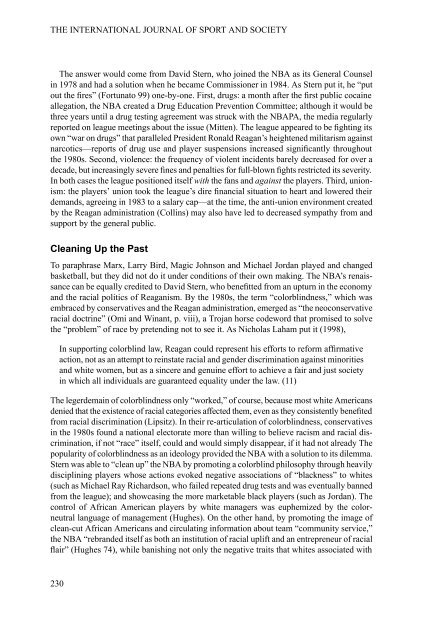Download - University of Minnesota
Download - University of Minnesota
Download - University of Minnesota
Create successful ePaper yourself
Turn your PDF publications into a flip-book with our unique Google optimized e-Paper software.
THE INTERNATIONAL JOURNAL OF SPORT AND SOCIETY<br />
The answer would come from David Stern, who joined the NBA as its General Counsel<br />
in 1978 and had a solution when he became Commissioner in 1984. As Stern put it, he “put<br />
out the fires” (Fortunato 99) one-by-one. First, drugs: a month after the first public cocaine<br />
allegation, the NBA created a Drug Education Prevention Committee; although it would be<br />
three years until a drug testing agreement was struck with the NBAPA, the media regularly<br />
reported on league meetings about the issue (Mitten). The league appeared to be fighting its<br />
own “war on drugs” that paralleled President Ronald Reagan’s heightened militarism against<br />
narcotics—reports <strong>of</strong> drug use and player suspensions increased significantly throughout<br />
the 1980s. Second, violence: the frequency <strong>of</strong> violent incidents barely decreased for over a<br />
decade, but increasingly severe fines and penalties for full-blown fights restricted its severity.<br />
In both cases the league positioned itself with the fans and against the players. Third, unionism:<br />
the players’ union took the league’s dire financial situation to heart and lowered their<br />
demands, agreeing in 1983 to a salary cap—at the time, the anti-union environment created<br />
by the Reagan administration (Collins) may also have led to decreased sympathy from and<br />
support by the general public.<br />
Cleaning Up the Past<br />
To paraphrase Marx, Larry Bird, Magic Johnson and Michael Jordan played and changed<br />
basketball, but they did not do it under conditions <strong>of</strong> their own making. The NBA’s renaissance<br />
can be equally credited to David Stern, who benefitted from an upturn in the economy<br />
and the racial politics <strong>of</strong> Reaganism. By the 1980s, the term “colorblindness,” which was<br />
embraced by conservatives and the Reagan administration, emerged as “the neoconservative<br />
racial doctrine” (Omi and Winant, p. viii), a Trojan horse codeword that promised to solve<br />
the “problem” <strong>of</strong> race by pretending not to see it. As Nicholas Laham put it (1998),<br />
In supporting colorblind law, Reagan could represent his efforts to reform affirmative<br />
action, not as an attempt to reinstate racial and gender discrimination against minorities<br />
and white women, but as a sincere and genuine effort to achieve a fair and just society<br />
in which all individuals are guaranteed equality under the law. (11)<br />
The legerdemain <strong>of</strong> colorblindness only “worked,” <strong>of</strong> course, because most white Americans<br />
denied that the existence <strong>of</strong> racial categories affected them, even as they consistently benefited<br />
from racial discrimination (Lipsitz). In their re-articulation <strong>of</strong> colorblindness, conservatives<br />
in the 1980s found a national electorate more than willing to believe racism and racial discrimination,<br />
if not “race” itself, could and would simply disappear, if it had not already The<br />
popularity <strong>of</strong> colorblindness as an ideology provided the NBA with a solution to its dilemma.<br />
Stern was able to “clean up” the NBA by promoting a colorblind philosophy through heavily<br />
disciplining players whose actions evoked negative associations <strong>of</strong> “blackness” to whites<br />
(such as Michael Ray Richardson, who failed repeated drug tests and was eventually banned<br />
from the league); and showcasing the more marketable black players (such as Jordan). The<br />
control <strong>of</strong> African American players by white managers was euphemized by the colorneutral<br />
language <strong>of</strong> management (Hughes). On the other hand, by promoting the image <strong>of</strong><br />
clean-cut African Americans and circulating information about team “community service,”<br />
the NBA “rebranded itself as both an institution <strong>of</strong> racial uplift and an entrepreneur <strong>of</strong> racial<br />
flair” (Hughes 74), while banishing not only the negative traits that whites associated with<br />
230

















